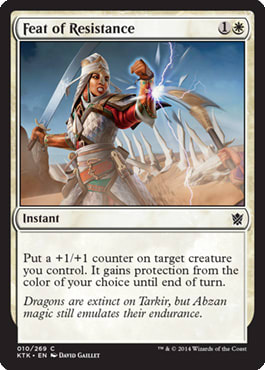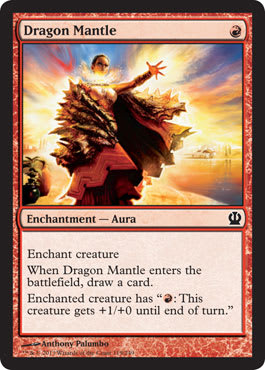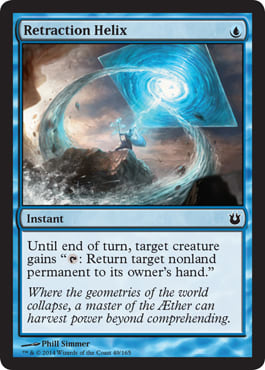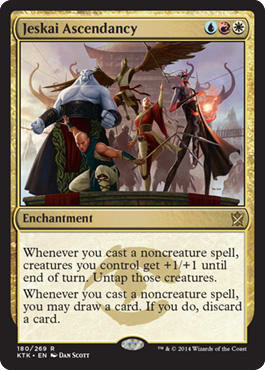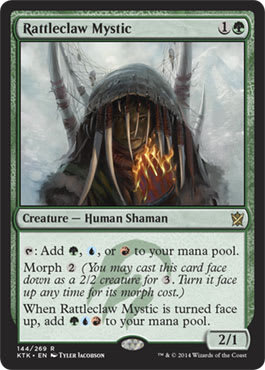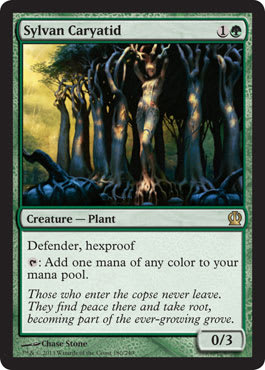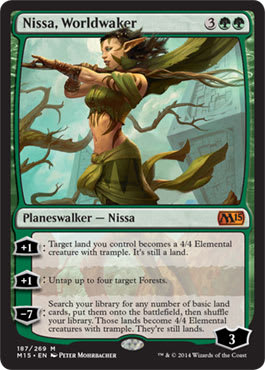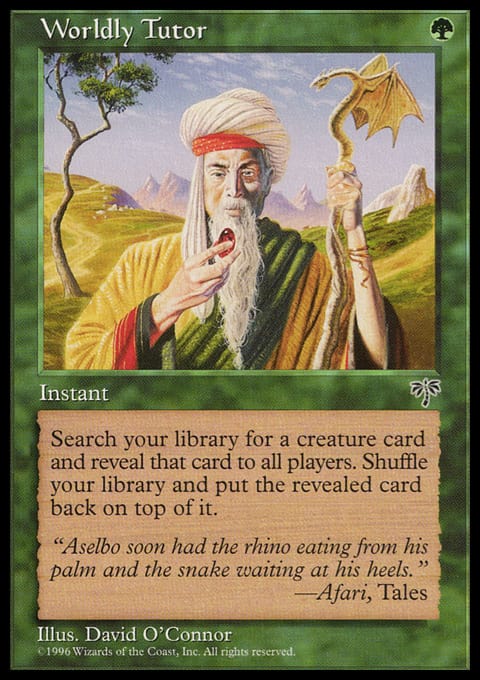
Photo Credit: Lee Shi Tian. Deck Registration Sheet
Lee Shi Tian filled out his Standard decklist for Pro Tour Khans of Tarkir on October 11. He flew in from Hong Kong on very little sleep, lacking the playtesting he was accustomed to before a major tournament. Despite this, he made Top 8.
[Cardlist Title= Umbrella Revolution (Jeskai Ascendancy) ? Khans of Tarkir Standard | Lee Shi Tian, Top 8 Pro Tour Khans of Tarkir]
- Lands (22)
- 4 Mana Confluence
- 2 Frontier Bivouac
- 2 Temple of Abandon
- 2 Temple of Mystery
- 2 Temple of Plenty
- 2 Yavimaya Coast
- 2 Wooded Foothills
- 2 Flooded Strand
- 1 Mountain
- 1 Forest
- 1 Island
- 1 Plains
- Creatures (11)
- 3 Kiora's Follower
- 4 Rattleclaw Mystic
- 4 Sylvan Caryatid
- Spells (27)
- 4 Commune with the Gods
- 3 Tormenting Voice
- 2 Twinflame
- 4 Retraction Helix
- 3 Dig Through Time
- 4 Dragon Mantle
- 4 Jeskai Ascendancy
- 2 Briber's Purse
- 1 Nissa, Worldwaker
- Sideboard (15)
- 4 Savage Knuckleblade
- 2 Polukranos, World Eater
- 3 Arc Lightning
- 3 Lightning Strike
- 3 Swan Song
In the Top 8 player profile, he alluded to the week that preceded his Top 8 placement:
Wizards’s coverage repeatedly mentioned how his deck was different from the “other Jeskai Ascendency combo decks.” They never took the actual step of using the deck’s name as given by the designer and pilot. When Top 8 decklists were posted, this is what we, the international community of players, will see from the Wizards of the Coast website:

While this is keeping with other moves Wizards has made involving accessibility for newer players and casual viewers, in this case, it is a specifically conservative political act. It’s not about crazy names or fear of trendiness—after all, we still refer to Cifka’s combo deck as Eggs and continue to argue about Affinity versus Robots in a public manner on coverage. It’s about the fact that if Wizards did allow this name to air as an official name, a large number of people would interpret it as Wizards allowing itself to be involved in a deeply political protest happening in Hong Kong right now.
Lee Shi Tian’s story would be covered in detail by sports press if he were an international athlete, but without community coverage, we may not know or understand what Umbrella Revolution is or why Wizards might need to avoid it. This essay will attempt to put this tweet into context:
Thanks @Photobycraig last time my tears bursting out was due to tear gas where i was only holding my umbrella #PTKTK pic.twitter.com/7vbSvM2W5t
— Lee Shi Tian (@leearson) October 13, 2014
Bonus: I won’t just be telling you about the history of Hong Kong and why young people are being tear-gassed to fight political corruption—Lee graciously explained the strategy of his take on the Jeskai combo to me and why he feels it represents an opening and closing of an umbrella. So if you stick with me, you’ll get some history, and you’ll also get a direct deck tech from the pro himself.
This One Time at the Magic Farm . . .
On September 28, Lee was playing in his usual space in a card shop called Magic Farm. As he explains, the community of Hong Kong Magic players doesn’t have a large number of competitive players, but the ones who do compete all have diverse opinions. His group is mostly populated by players with university degrees—and at least one PhD type. They are very willing to stand up for their independent ideas and defend them. As a result, their competitive community has something a rep for arguing a lot amongst themselves, but Lee says, “I tend to call it “discuss” because it never got to hurt our relationship.” It was 2:00 A.M. when they were “discussing” their playtest ideas and the events of Occupy Central made it into the shop. Outside the store, thousands of people had just joined a two-day-old sit-in started by students, protesting for the right to vote and choose candidates in their own elections. Back in 2007, universal suffrage for Hong Kong was supposed to begin in 2017, and China was taking the possibility of full, open elections off the table. Police had attacked the protesters using tear gas. Inside the Magic Farm, Lee and his playgroup were shocked that the police would go after peaceful protesters like that.
Who Are the Protesters? Occupy Central and Hong Kong Class Boycott
Originally, the protest was designed as a nonviolent sit-in that expected to move around and build support as it went along. According to Chris Yeung, writing for The Atlantic, the movement organizers expected to be disbanded by the police. Protesters repurposed the metal barriers used by police to keep them in their zones and barricaded themselves in. On Friday the 26th, police stormed the city headquarters and arrested the students. The Occupy Central movement joined the students on Sunday morning (Yeung, 2014). That Sunday morning, Lee and his playtest group joined the protestors. Knowing that tear gas had been used the night before, they went out into the streets with plastic wrap and umbrellas to be used to protect themselves. “We knew we have to do something to take up our own responsibility to Hong Kong.” Their playtesting time was over. The movement out in the street at that time was made up of several separate pro-democracy groups. There is a student-led one, with the leadership of Joshua Wong, Alex Chow, and Lester Shum. Wong had been detained before the 28th and was not initially aware of the use of tear gas on his fellow students. Joshua Wong is seventeen years old and leads a movement he started in 2012 called Scholarism. Chow is twenty-four and the leader of the Hong Kong Federation of Students (Srivastava, 2014). Benny Tai is an older leader who planned to use the protest styles of Occupy Wall Street as a model for a group called Occupy Central with Love and Peace. Chow took the idea of Tai’s concept, and he started a protest action with a clear timeline. It was meant to be a one-week boycott of classes. Tai had a different timeline for his group’s protest, but they joined the rush of support the students were receiving. He declared Occupy Central on the Sunday that Lee and his playgroup joined the protests. Originally, those leaders planned for a maximum of three thousand protesters to be involved, but tens of thousands were in the streets (Yeung, Srivastava: 2014). Remember when you read news articles that most news reports are trying to make it look like one unified movement, but it is a popular movement in the literal sense—the population is protesting. There is no singular leadership person or group. The protest is generally about being able to vote for Hong Kong elected officials without Beijing manipulating the available candidates, but that might be the only thing on which they would all agree.
How Long Was Lee With Them?
During the week of protests, meetings with the government were scheduled and canceled—counter-protesters, who were suspected to be paid to commit violence, affected the demonstrators, and the movement rose with a surge of over two hundred thousand people participating in the protests (Srivastava, 2014). Lee and his playtest group were out there later that morning and in the streets.
Got a GP to win #gpshanghai Got a PT to break #ptktk But nothing more important than got a home to save #occupycentral #hkclassboycott
— Lee Shi Tian (@leearson) September 29, 2014
“Every day after work, we simply go to the street, participating in the protest and doing what we think is right,” Lee explained. Because it was a peaceful protest for most of that week, the playgroup was still able to support Lee in his competitive goals. “We do have time sitting at the street and do our own stuff.”
“At that time, we simply discuss the deck over messages and discuss about the pros and cons of each card. And here we get the shell of the deck-build, mostly based on paper instead of on real playtest.”
That’s right: The only Jeskai Ascendency combo deck that made it to the Top 8 of the Pro Tour couldn’t be playtested—it was all Mental Magic while protesting.
Lee was tear-gassed that first day.
“Long story short, in the end, our Handy Warp and Umbrella was interpreted as “weapon.” They fired off their weapon while thousands of citizens was in the streets holding their hands up with umbrella. I got tear-gassed, but I am not sure it was the tear gas or the desperation of my broken heart.”

Photo by Pasu Au Yeung under the Wikicommons License 7 October 2014, 20:37:55
So How about That Name?
“P.S. People start naming the movement “Umbrella Revolution” the week after,” Lee says.
There are several interesting elements involved in Lee’s naming his deck Umbrella Revolution. He specifically thinks of the mechanics of the combo in those terms. So let’s look at his answer to my question. “You mentioned that your version of the Ascendency combo really did open and close like an umbrella—could you describe that for people who are not as good at the game's mechanics so they can see how that works both in game play and poetically?”
Lee’s Explanation
The deck includes two parts; “Umbrella” is the loop, and “Revolution” is the kill.
The Umbrella: The infinite loop of the combo includes Retraction Helix’d creatures that can return Dragon Mantle or Briber's Purse.
With Jeskai Ascendancy in play, the returned Dragon Mantle or Briber's Purse feels like the button of a umbrella.
Every time you tap all your creatures, you will be closing an umbrella, and casting Dragon Mantle or Briber's Purse will be opening it up.
You will get your mana dorks and Retraction Helix’d creature untapped, and the loop goes on and on.
Ultimately, you will draw the win condition from the looting effect of Jeskai Ascendancy.
The Revolution: After you generate infinite mana with two mana dorks and a Briber's Purse, you can:
- Cast a second Retraction Helix and return every nonland permanent under your opponent's control, clearing all the blockers.
- Gather all the creatures in your deck and Twinflame them into attackers.
- Nissa, Worldwaker can turn one of your lands into a creature, and you can always bounce Nissa and recast her to make another land a creature.
With these, you can always assemble enough 689-and-higher-power creatures and attack for the lethal.
Everything just started simply from some 2/2s and lands; like revolution, it is always starting with a spark but turning into wildfire.
So Why Didn’t Wizards Tell Lee’s Story or Use the Name?
So this is where it becomes complicated and becomes an issue of Wizards being an international organization that is also a corporation. Wizards has dealt with issues such as making sure it doesn’t violate gambling laws in specific countries. For the Magic World Cup, the team from Taiwan could not be called Team Taiwan; they had the awkward, compromised solution of being called Chinese Taipei that was first negotiated in the 1970s with the International Olympic Committee. China is not just a large market, it is also a major part of competitive Magic on the international scene, and the Chinese government can make it very difficult for its players to be competitive in Pro Tours if they decided to remove Magic from the list of approved competitions in the country. Wizards staying neutral protects all the players. Wizards also didn’t suppress Lee’s own statements about his deck in his Top 8 Profile or in his Round 16 Feature Match. And that brings us to the tweet with him crying. That was when he made it into the Top 8. The feature match article ends this way:
Everybody around congratulated him, and then Lee sat back down in his chair, curled his legs a bit, and started to cry.
He looked up at us at said, "Things have been so hard for Hong Kong."
"This means so much to me."
However, at no point does anyone ever explain why. This is the explanation.
Currently in the Magic community, there is no real long-form journalism on some of the political events that affect our players and our communities. The Deck Tease podcast by Erin Campbell here on Gathering Magic has broken new ground in the interview style of podcasting, but that format is best for strong personalities who speak well and, frankly, speak English. As you can see by the gist of this article, putting these stories into context is not a short-form exercise. There’s a reason most newspapers and magazines have stopped doing longer pieces. I think they are important to the community if we are going to recognize that our competitive players may be younger and mostly male, but young people in their twenties are some of the people who are fighting wars, protesting for peace, reforming governments, preserving governments, working for inclusion, and working against inclusion. There aren’t a lot of political events that happen—that people risk themselves in—that are “easy to root for.” Even the use of the name Umbrella Revolution is contested, with some writers trying to make a case that it’s incendiary (Yeung, 2014). It makes it complicated for the Wizards coverage team in a way that ESPN, for example, doesn’t have to deal with. So the question becomes, Is there a place for this kind of coverage in long form outside of the Wizards of the Coast stream? Is there interest? Should we in the community media at least be the ones to honor the deck names chosen by the players because we don’t have the political (or propriety) concerns that Wizards does?
My own feeling is that when a player in a prominent position makes a political statement, we should find a way to cover it. As long as it doesn’t violate Network Broadcast Standards, we should publish the player’s name for the deck next to the official Wizards label in the way that Gathering Magic has for 5 Decks You Can’t Miss This Week.
I’d like to end with Lee’s own take on Wizards of the Coast’s use of the deck name.
Special thanks
For many reasons, I will say I understand WotC cannot have my deck named under Umbrella Revolution.
In the end, it is a business company, and my personal wish is just a speck of dust. And I will never blame them not respecting my deck name.
In the end, it is not about how they name the deck. It is all about what the community calls it (as how you simply won't refer to Junk as Abzan).
Here I’m sending out my thanks to people supporting me in the community. My own power may be little, but with you all, there is always a hope.
May be one day, I will create another combo deck surrounded with Jeskai Ascendancy. And the conversation will become this:
Person A: Did you try Jeskai Ascendancy Combo?
Person B: Which one are you talking about? Umbrella Revolution or the token one?
See? Nice and easy =)
Thanks and regards,
Arson Lee

Worldly Tutor Bonus History Lesson
Hong Kong was leased to the British after the Opium War in 1898. It was kind of squatter’s rights because they had held Hong Kong for about fifty years before that—because colonialism is a thing.
It was a ninety-nine-year lease, which meant it was a tiny part of Asia under specifically British rule all the way through World War I, World War II, The Sino–Japanese War, and Mao’s Cultural Revolution until the lease was up in 1997. It’s an oversimplification, sure, but basically, try to imagine the whole run of 20th Century New York City being dislocated into the middle of a country that ended up communist after a while, while New York magically was able to keep being New York. Then, the lease is up, and all New Yorkers are told they have to be ruled exactly the way the rest of the country is (Young, 2010). Needless to say, it didn’t go over well. Hong Kong was unabashedly capitalistic and democratic compared to Mainland China. Even though all three sides (China, Britain, and Hong Kong) worked on the transfer for fifteen years, the differences were fundamental. Also, let’s think about this in relation to Magic: The Gathering: Magic is twenty years old. China having political control over Hong Kong is only 17.
As a matter of fact, here is some interesting international MTG organized-play trivia for you: Hong Kong and China have had separate National Champions from the beginning of their competition in organized play regional systems through today. Lee has been Hong Kong’s National champ for the last two years, Bo Li was China’s in 2013, and Han Bing holds the title for the Chinese Mainland this year. While Mainland China was actually putting laws on the books to make Magic: The Gathering an officially recognized “Exhibition Mind sport,” allowing it to be played on the mainland and participate in the international competition, it was also negotiation with Hong Kong on election law (Sideboard, 2000).
More Recent History
It’s a little too detailed to go into, but the bottom line comes down to this: There was an attempt to create a “One Government, Two Systems” version where Hong Kong was able to continue being a capitalistic, democratic kind of place while still being absorbed into the concept of a unified China. Essentially, under a colonial government system for one hundred fifty years, there was a strong two-tier system of local parliamentary rule under a governorship; in the current Hong Kong government system, the powers of the governor are now mostly transferred to the Chief Executive. In news accounts, you will see sentences like this from 1997: “Tung Chee-hwa, a Shanghai-born former shipping tycoon with no political experience, is hand-picked by Beijing to rule the territory following the takeover” (BBC, 2014). When you see the word “Beijing,” it means “Chinese Government” the same way “Washington” means “US Government.”
You can imagine this went about as well as having Putin appoint the new governor of New York. In 2002, the guy picked by China for his excellent business sense introduces an anti-subversion law known as Article 23. To summarize, the Hong Kongers were concerned:
- That tying their law to China’s list of “banned organizations” would lead to a suppression of dissidents and journalists without real due process;
- That the wording of the article made “country” and “government” equivalent instead of specifying citizens as being part of the country and could be used to prevent citizen oversight or government accountability;
- That it legalized warrantless searches and created the possibility of life sentences in prison based on “instigative speech”;
The type of protests currently being held in Hong Kong is very similar to the protests that started against Article 23.
Sources Cited
- Branigan, Tania, and Jonathan Kalamn. 2014. “Hong Kong Police Use Teargas and Pepper Spray to Disperse Protesters | World News | The Guardian.” The Guardian. http://www.theguardian.com/world/2014/sep/28/kong-kong-police-teargas-pepper-spray-pro-democracy-protesters.
- “Bzle-pICIAAK55v.jpg:large (JPEG Image, 1024 × 271 Pixels).” 2014. Accessed October 15. https://pbs.twimg.com/media/Bzle-pICIAAK55v.jpg:large.
- Fields, Liz. 2014. “Police Fire Tear Gas as Occupy Central Protests Take Over Hong Kong | VICE News.” Vice News Asia & Pacific. https://news.vice.com/article/police-fire-tear-gas-as-occupy-central-protests-take-over-hong-kong.
- “Hong Kong Profile.” 2014. Accessed October 15. http://www.bbc.com/news/world-asia-pacific-16526765.
- “Lee Shi Tian on Twitter: ‘Deck Name Chosen #UmbrellaRevolution Honour to Hong Kongers Should I Root for Deck Tech No Politic, Only Dream #PTKTK http://t.co/PNVPSKSOSI.’” 2014. Accessed October 15. https://twitter.com/leearson/status/520551663329759232.
- “Lee Shi Tian on Twitter: ‘Glad the Deck Got Me All the Way to Top 8 Wish Mtg Community Can Honour the Name of My Ascendancy Combo Build as #umbrellarevolution #ptktk.’” 2014. Accessed October 15. https://twitter.com/leearson/status/521277742302515200.
- “Magic: The Gathering - Sideboard Article.” 2014. Accessed October 15. http://www.wizards.com/Sideboard/mtg_article.asp?sb20000517a
- “Occupy Central Is Not Like Previous Protest Movements | VICE News.” 2014. Accessed October 15. https://news.vice.com/article/occupy-central-is-not-like-previous-protest-movements.
- Srivastava, Mehul, Jonathan Browning, Natasha Khan, and Fion Li. 2014. “How Tear Gas Attack Ignited Hong Kong Democracy Protests - Bloomberg.” Bloomberg News. http://www.bloomberg.com/news/2014-10-09/how-hong-kong-got-caught-off-guard-by-student-protests.html.
- Yeung, Chris. 2014. “Don’t Call Hong Kong's Protests an ‘Umbrella Revolution’ – The Atlantic.” The Atlantic. Accessed October 17. http://www.theatlantic.com/international/archive/2014/10/dont-call-hong-kongs-protests-an-umbrella-revolution/381231/
- Young, Simon N. M, and Richard Cullen. 2010. Electing Hong Kong’s Chief Executive. Hong Kong: Hong Kong University Press. http://public.eblib.com/choice/publicfullrecord.aspx?p=677262













